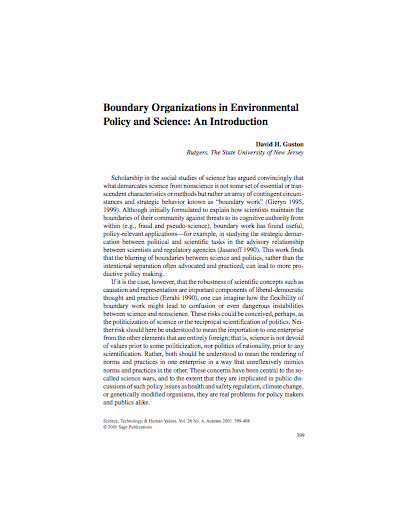
"Scholarship in the social studies of science has argued convincingly that what demarcates science from nonscience is not some set of essential or transcendent characteristics or methods but rather an array of contingent circumstances and strategic behavior known as “boundary work” (Gieryn 1995, 1999). Although initially formulated to explain how scientists maintain the boundaries of their community against threats to its cognitive authority from within (e.g., fraud and pseudo-science), boundary work has found useful, policy-relevant applications—for example, in studying the strategic demarcation between political and scientific tasks in the advisory relationship between scientists and regulatory agencies (Jasanoff 1990). This work finds that the blurring of boundaries between science and politics, rather than the intentional separation often advocated and practiced, can lead to more productive policy making.
If it is the case, however, that the robustness of scientific concepts such as causation and representation are important components of liberal-democratic thought and practice (Ezrahi 1990), one can imagine how the flexibility of boundary work might lead to confusion or even dangerous instabilities between science and nonscience. These risks could be conceived, perhaps, as the politicization of science or the reciprocal scientification of politics. Neither risk should here be understood to mean the importation to one enterprise from the other elements that are entirely foreign; that is, science is not devoid of values prior to some politicization, nor politics of rationality, prior to any scientification. Rather, both should be understood to mean the rendering of norms and practices in one enterprise in a way that unreflexively mimics norms and practices in the other. These concerns have been central to the socalled science wars, and to the extent that they are implicated in public discussions of such policy issues as health and safety regulation, climate change, or genetically modified organisms, they are real problems for policy makers and publics alike.
Recognizing both that there is no unbridgeable chasm between science and nonscience and that the flexibility of boundary work may threaten some important values and interests, scholars have discussed some possible factors that contribute to linking the two domains and stabilizing some boundary work. These include the identification of boundary objects, standardized packages, and now, boundary organizations."
David H. Guston, "2001. Guston. "Boundary Organizations in Environmental Policy and Science: An Introduction"", contributed by Maggie Woodruff, STS Infrastructures, Platform for Experimental Collaborative Ethnography, last modified 29 May 2018, accessed 26 December 2024. https://stsinfrastructures.org/content/2001-guston-boundary-organizations-environmental-policy-and-science-introduction
Critical Commentary
This 2001 article by David H. Guston explores the concept of "boundary work" in relation to environmental policy and science.